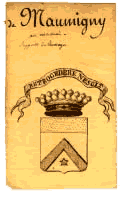Essential Heraldic Pieces

Greyhound crest and torse
The Crest
This device was worn on top of the helmet, and was usually made of wood, metal, or boiled leather. It provided the double advantage of easy identification and the addition of height to the wearer. In heraldry today, the crest and arms are usually displayed together.
Torse (Force or Wreath)
Formed by two pieces of silk twisted together by the lady who chose the bearer for her knight, the torse was used to hold the crest and mantling in place on the Helm. The tinctures of the torse are always those of the principal metal and color of the arms, the exception being in continental heraldry.

Coat of arms with motto
Motto
The Motto generally evolved from the watchword or war-cry of the family. Often the motto contained an allusion to a memorable event in the family history, for example: the Bruce motto "Fuimus" (Latin - "We were") refers to the fact that the family were once the kings of Scotland.
Arms
Originally the term meant the coat worn over a knight's armour. The term later evolved to mean the full achievement of arms included arms, crest and motto if they were recorded. The oldest coats of arms were just the arms and were generally of a very simple design. Crests and mottoes were often added later. Complex arms were usually a result of many generations of improvements or enhancements or honors that were duly recognized.

Helm, mantling, and
arms or shield
One of the first "arms" was likely just a silver or gold shield. Then, shields were painted simply with one or more bands of color or "ordinaries". Later the ordinaries were used in conjunction with other figures or symbols: beasts, birds, fish, flowers, celestial and ecclesiastical objects, monsters, and much more. Heraldry was thus rapidly enriched by the constant necessity to achieve distinction.
Helm (Helmet, Casque or Morion)
These varied in shape in different ages and countries. The Esquire's Helm, as depicted in family arms, is always with closed visor and facing to the left. One must always remember that as you view arms or devices in heraldry most elements are facing the left but are regarded as to the dexter or right side of the arms. Like the stage, where 'stage-left' is viewed as the 'right' side of the stage if one was seated in the audience, heraldry is based on the same perspective. In other words, if a device is described as 'sinister', it faces the right side of the shield as we view it. Many a layman or commercial artist have wrongly drawn an arms in 'sinister' not understanding the mistake they have made.
Mantling
The mantling was spread over and draped from the helmet, and served as protection: "to repel the extremities of wet, cold and heat" and to preserve the armor from rust. The numerous cuts and slits indicated it had been torn and hacked in the field of battle, and betokened a certain evidence of prowess.
References
- ^ Swyrich, Archive materials